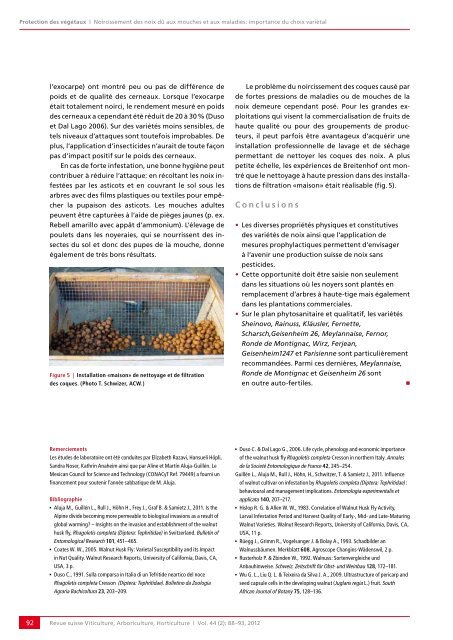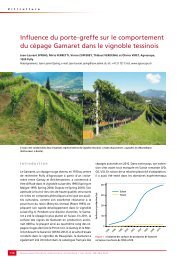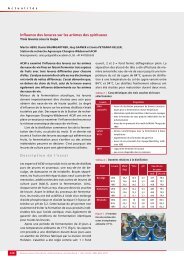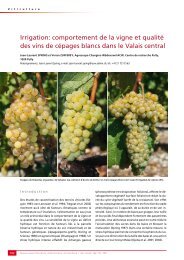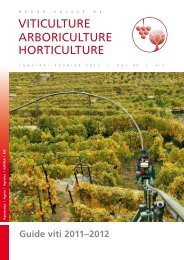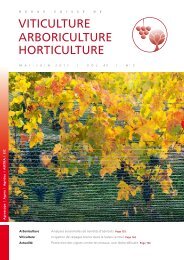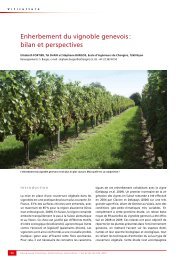Télécharger le PDF - Revue suisse de viticulture arboriculture ...
Télécharger le PDF - Revue suisse de viticulture arboriculture ...
Télécharger le PDF - Revue suisse de viticulture arboriculture ...
Create successful ePaper yourself
Turn your PDF publications into a flip-book with our unique Google optimized e-Paper software.
Protection <strong>de</strong>s végétaux | Noircissement <strong>de</strong>s noix dû aux mouches et aux maladies: importance du choix variétal<br />
92<br />
l’exocarpe) ont montré peu ou pas <strong>de</strong> différence <strong>de</strong><br />
poids et <strong>de</strong> qualité <strong>de</strong>s cerneaux. Lorsque l’exocarpe<br />
était tota<strong>le</strong>ment noirci, <strong>le</strong> ren<strong>de</strong>ment mesuré en poids<br />
<strong>de</strong>s cerneaux a cependant été réduit <strong>de</strong> 20 à 30 % (Duso<br />
et Dal Lago 2006). Sur <strong>de</strong>s variétés moins sensib<strong>le</strong>s, <strong>de</strong><br />
tels niveaux d’attaques sont toutefois improbab<strong>le</strong>s. De<br />
plus, l’application d’insectici<strong>de</strong>s n’aurait <strong>de</strong> toute façon<br />
pas d’impact positif sur <strong>le</strong> poids <strong>de</strong>s cerneaux.<br />
En cas <strong>de</strong> forte infestation, une bonne hygiène peut<br />
contribuer à réduire l’attaque: en récoltant <strong>le</strong>s noix infestées<br />
par <strong>le</strong>s asticots et en couvrant <strong>le</strong> sol sous <strong>le</strong>s<br />
arbres avec <strong>de</strong>s films plastiques ou texti<strong>le</strong>s pour empêcher<br />
la pupaison <strong>de</strong>s asticots. Les mouches adultes<br />
peuvent être capturées à l’ai<strong>de</strong> <strong>de</strong> pièges jaunes (p. ex.<br />
Rebell amarillo avec appât d’ammonium). L’é<strong>le</strong>vage <strong>de</strong><br />
pou<strong>le</strong>ts dans <strong>le</strong>s noyeraies, qui se nourrissent <strong>de</strong>s insectes<br />
du sol et donc <strong>de</strong>s pupes <strong>de</strong> la mouche, donne<br />
éga<strong>le</strong>ment <strong>de</strong> très bons résultats.<br />
Figure 5 | Installation «maison» <strong>de</strong> nettoyage et <strong>de</strong> filtration<br />
<strong>de</strong>s coques. (Photo T. Schwizer, ACW.)<br />
Remerciements<br />
Les étu<strong>de</strong>s <strong>de</strong> laboratoire ont été conduites par Elizabeth Razavi, Hansueli Höpli,<br />
Sandra Noser, Kathrin Anaheim ainsi que par Aline et Martín Aluja-Guillén. Le<br />
Mexican Council for Science and Technology (CONACyT Ref. 79449) a fourni un<br />
financement pour soutenir l’année sabbatique <strong>de</strong> M. Aluja.<br />
Bibliographie<br />
b Aluja M., Guillén L., Rull J., Höhn H., Frey J., Graf B. & Samietz J., 2011. Is the<br />
Alpine divi<strong>de</strong> becoming more permeab<strong>le</strong> to biological invasions as a result of<br />
global warming? – Insights on the invasion and establishment of the walnut<br />
husk fly, Rhago<strong>le</strong>tis comp<strong>le</strong>ta (Diptera: Tephritidae) in Switzerland. Bul<strong>le</strong>tin of<br />
Entomological Research 101, 451–465.<br />
b Coates W. W., 2005. Walnut Husk Fly: Varietal Susceptibility and its Impact<br />
in Nut Quality. Walnut Research Reports, University of California, Davis, CA,<br />
USA, 3 p.<br />
b Duso C., 1991. Sulla comparsa in Italia di un Tefriti<strong>de</strong> neartico <strong>de</strong>l noce<br />
Rhago<strong>le</strong>tis comp<strong>le</strong>ta Cresson (Diptera: Tephritidae). Bol<strong>le</strong>tino da Zoologia<br />
Agraria Bachicoltura 23, 203–209.<br />
<strong>Revue</strong> <strong>suisse</strong> Viticulture, Arboriculture, Horticulture | Vol. 44 (2): 88–93, 2012<br />
Le problème du noircissement <strong>de</strong>s coques causé par<br />
<strong>de</strong> fortes pressions <strong>de</strong> maladies ou <strong>de</strong> mouches <strong>de</strong> la<br />
noix <strong>de</strong>meure cependant posé. Pour <strong>le</strong>s gran<strong>de</strong>s exploitations<br />
qui visent la commercialisation <strong>de</strong> fruits <strong>de</strong><br />
haute qualité ou pour <strong>de</strong>s groupements <strong>de</strong> producteurs,<br />
il peut parfois être avantageux d’acquérir une<br />
installation professionnel<strong>le</strong> <strong>de</strong> lavage et <strong>de</strong> séchage<br />
permettant <strong>de</strong> nettoyer <strong>le</strong>s coques <strong>de</strong>s noix. A plus<br />
petite échel<strong>le</strong>, <strong>le</strong>s expériences <strong>de</strong> Breitenhof ont montré<br />
que <strong>le</strong> nettoyage à haute pression dans <strong>de</strong>s installations<br />
<strong>de</strong> filtration «maison» était réalisab<strong>le</strong> (fig. 5).<br />
Conclusions<br />
• Les diverses propriétés physiques et constitutives<br />
<strong>de</strong>s variétés <strong>de</strong> noix ainsi que l’application <strong>de</strong><br />
mesures prophylactiques permettent d’envisager<br />
à l’avenir une production <strong>suisse</strong> <strong>de</strong> noix sans<br />
pestici<strong>de</strong>s.<br />
• Cette opportunité doit être saisie non seu<strong>le</strong>ment<br />
dans <strong>le</strong>s situations où <strong>le</strong>s noyers sont plantés en<br />
remplacement d’arbres à haute-tige mais éga<strong>le</strong>ment<br />
dans <strong>le</strong>s plantations commercia<strong>le</strong>s.<br />
• Sur <strong>le</strong> plan phytosanitaire et qualitatif, <strong>le</strong>s variétés<br />
Sheinovo, Rainuss, Kläus<strong>le</strong>r, Fernette,<br />
Scharsch,Geisenheim 26, Meylannaise, Fernor,<br />
Ron<strong>de</strong> <strong>de</strong> Montignac, Wirz, Ferjean,<br />
Geisenheim1247 et Parisienne sont particulièrement<br />
recommandées. Parmi ces <strong>de</strong>rnières, Meylannaise,<br />
Ron<strong>de</strong> <strong>de</strong> Montignac et Geisenheim 26 sont<br />
en outre auto-ferti<strong>le</strong>s. �<br />
b Duso C. & Dal Lago G., 2006. Life cyc<strong>le</strong>, phenology and economic importance<br />
of the walnut husk fly Rhago<strong>le</strong>tis comp<strong>le</strong>ta Cresson in northern Italy. Anna<strong>le</strong>s<br />
<strong>de</strong> la Societé Entomologique <strong>de</strong> France 42, 245–254.<br />
Guillén L., Aluja M., Rull J., Höhn, H., Schwitzer, T. & Samietz J., 2011. Influence<br />
of walnut cultivar on infestation by Rhago<strong>le</strong>tis comp<strong>le</strong>ta (Diptera: Tephritidae):<br />
behavioural and management implications. Entomologia experimentalis et<br />
applicata 140, 207–217.<br />
b Hislop R. G. & Al<strong>le</strong>n W. W., 1983. Correlation of Walnut Husk Fly Activity,<br />
Larval Infestation Period and Harvest Quality of Early-, Mid- and Late-Maturing<br />
Walnut Varieties. Walnut Research Reports, University of California, Davis, CA,<br />
USA, 11 p.<br />
b Rüegg J., Grimm R., Vogelsanger J. & Bolay A., 1993. Schadbil<strong>de</strong>r an<br />
Walnussbäumen. Merkblatt 608, Agroscope Changins-Wä<strong>de</strong>nswil, 2 p.<br />
b Rusterholz P. & Zbin<strong>de</strong>n W., 1992. Walnuss: Sortenverg<strong>le</strong>iche und<br />
Anbauhinweise. Schweiz. Zeitschrift für Obst- und Weinbau 128, 172–181.<br />
b Wu G. L., Liu Q. L. & Teixeira da Silva J. A., 2009. Ultrastructure of pericarp and<br />
seed capsu<strong>le</strong> cells in the <strong>de</strong>veloping walnut (Juglans regia L.) fruit. South<br />
African Journal of Botany 75, 128–136.


